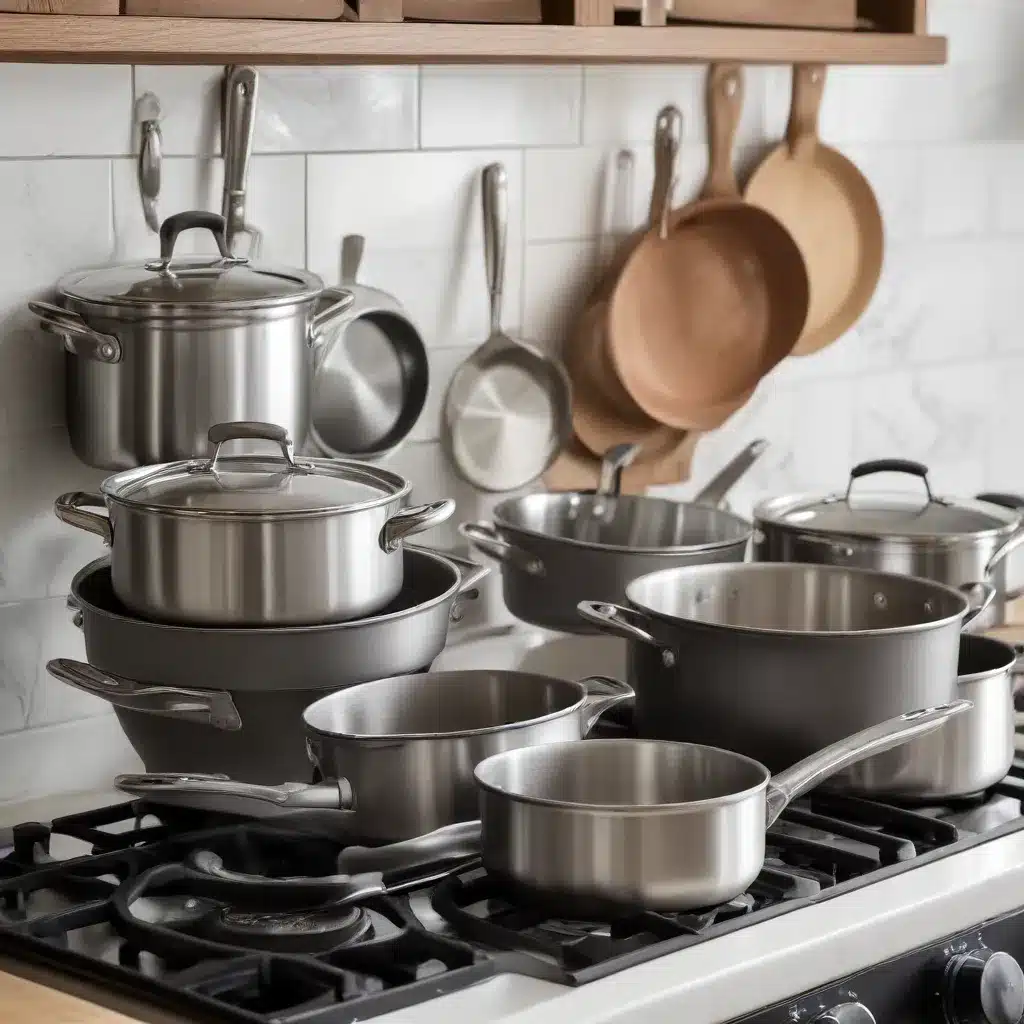
Mastering the Art of Cookware Care
As seasoned culinary professionals, we understand the importance of maintaining our kitchen equipment in pristine condition. Pots and pans are the backbone of any well-equipped kitchen, enabling us to create delectable meals with ease. However, the bane of every cook’s existence is the dreaded stuck-on mess – those stubborn, burnt-on bits that can seem impossible to remove.
Fear not, fellow Kitchen Warriors! In this comprehensive guide, we’ll share our expert techniques and practical tips to help you prevent and tackle these culinary conundrums, ensuring your cookware remains in peak condition for years to come.
Understanding the Causes of Stuck-On Messes
Before we dive into the solutions, it’s essential to understand the common causes of stuck-on messes in our beloved pots and pans. These occur for a variety of reasons, from improper heating techniques to the use of the wrong tools.
One of the primary culprits is high-heat cooking, where food is left to sizzle and scorch on the bottom of the pan. This can happen when searing meats, reducing sauces, or even simply forgetting to stir a dish. The intense heat causes the food particles to bond with the surface of the pan, creating a stubborn, difficult-to-remove layer.
Additionally, using the wrong utensils, such as metal spatulas or forks, can scratch and wear down the interior of pans, particularly those with nonstick coatings. This can lead to food particles becoming lodged in the scratches, making them even harder to clean.
Preventing Stuck-On Messes: Techniques and Tools
The old adage “an ounce of prevention is worth a pound of cure” certainly rings true when it comes to maintaining pristine pots and pans. By implementing a few simple strategies, you can significantly reduce the likelihood of dealing with those dreaded stuck-on messes.
Proper Heating and Cooking Techniques
- Gradual Heating: Start with a lower heat setting and gradually increase the temperature as needed. Sudden, high-heat exposure is a surefire way to invite stubborn food residue.
- Consistent Stirring: Keep a close eye on your dishes and stir them regularly to prevent food from burning and sticking to the pan.
- Deglaze and Scrape: When cooking, make a habit of deglazing the pan with a small amount of liquid, such as broth or wine, and using a wooden or silicone spatula to gently scrape up any browned bits.
Proper Cookware Selection and Care
- Choose the Right Pans: Invest in high-quality, durable cookware that is designed to withstand the rigors of everyday use. Stainless steel and cast iron are excellent options, as they are less prone to scratches and discoloration.
- Use Appropriate Utensils: Stick to wooden, silicone, or nylon utensils when cooking to avoid scratching the surface of your pans. Avoid using metal tools, as they can damage the pan’s interior and create crevices for food to become trapped.
- Avoid Harsh Abrasives: Steer clear of steel wool, abrasive sponges, or harsh cleaners, as these can wear down the surface of your pots and pans over time. Opt for gentler cleaning methods, such as a soft sponge or cloth.
Tackling Stubborn Stuck-On Messes
Despite our best efforts, sometimes even the most experienced cooks encounter those stubborn, stuck-on messes. When this happens, it’s essential to have a few tricks up our sleeves to tackle the problem head-on.
The Dryer Sheet Soak
One innovative solution that has gained popularity in recent years is the dryer sheet soak. As reported by Food52, this simple technique can work wonders on even the most heavily charred pans.
To try this method, simply place a single dryer sheet (or fabric softener sheet) in the bottom of the affected pan, add enough warm water to cover the stuck-on residue, and let it soak for 15-20 minutes, or even overnight for stubborn cases. The conditioning properties of the dryer sheet help to break down the stuck-on mess, making it easier to wipe away.
Baking Soda and Vinegar
Another effective method for tackling tough stains and stuck-on messes is the classic baking soda and vinegar combination. As suggested by the Reddit community, simply sprinkle a generous amount of baking soda in the affected pan, followed by a few splashes of white vinegar. Allow the mixture to sit and bubble for a few minutes before scrubbing with a non-abrasive sponge or cloth.
The chemical reaction between the baking soda and vinegar helps to break down and lift the stuck-on grime, leaving your pans looking like new.
Avoiding Scratches and Preserving Longevity
In addition to preventing and tackling stuck-on messes, it’s equally important to protect the integrity of your cookware to ensure its longevity. As suggested by USA Today, one of the best ways to do this is by choosing the right utensils and cookware materials.
Stainless steel and cast iron are excellent options, as they are less prone to scratches and discoloration than their nonstick counterparts. When it comes to utensils, opt for wooden, silicone, or nylon tools, as these are less likely to scratch the surface of your pans.
Additionally, be mindful of how you store your cookware. Avoid stacking pots and pans on top of each other, as this can lead to scratches and dents. Instead, consider using pan protectors or storing them separately to preserve their pristine condition.
Conclusion: Elevating Your Cooking Experience
By mastering the art of cookware care, you’ll not only prevent those dreaded stuck-on messes but also elevate your overall cooking experience. With pristine pots and pans at your disposal, you’ll be able to focus on the true joy of creating delectable dishes, without the frustration of scrubbing and scraping.
Remember, a little bit of prevention and a few simple cleaning techniques can go a long way in maintaining the longevity and performance of your cherished kitchen tools. Embrace these strategies, and let your culinary prowess shine through, all while keeping your pots and pans in pristine condition.


